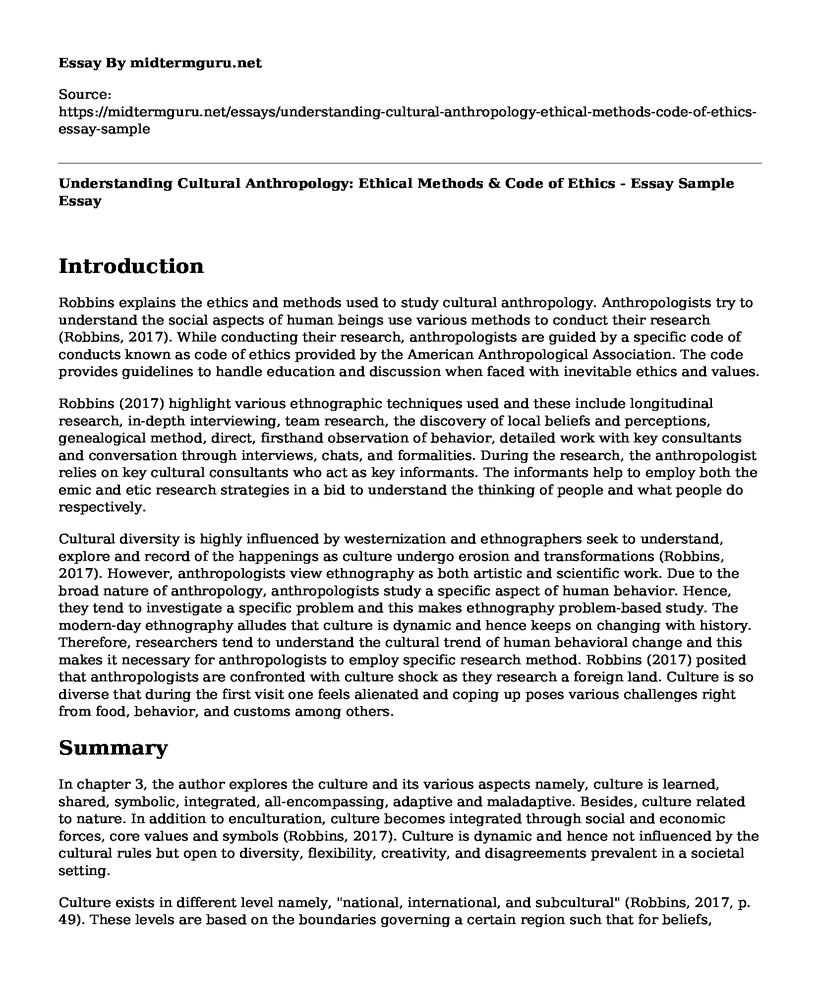Introduction
Robbins explains the ethics and methods used to study cultural anthropology. Anthropologists try to understand the social aspects of human beings use various methods to conduct their research (Robbins, 2017). While conducting their research, anthropologists are guided by a specific code of conducts known as code of ethics provided by the American Anthropological Association. The code provides guidelines to handle education and discussion when faced with inevitable ethics and values.
Robbins (2017) highlight various ethnographic techniques used and these include longitudinal research, in-depth interviewing, team research, the discovery of local beliefs and perceptions, genealogical method, direct, firsthand observation of behavior, detailed work with key consultants and conversation through interviews, chats, and formalities. During the research, the anthropologist relies on key cultural consultants who act as key informants. The informants help to employ both the emic and etic research strategies in a bid to understand the thinking of people and what people do respectively.
Cultural diversity is highly influenced by westernization and ethnographers seek to understand, explore and record of the happenings as culture undergo erosion and transformations (Robbins, 2017). However, anthropologists view ethnography as both artistic and scientific work. Due to the broad nature of anthropology, anthropologists study a specific aspect of human behavior. Hence, they tend to investigate a specific problem and this makes ethnography problem-based study. The modern-day ethnography alludes that culture is dynamic and hence keeps on changing with history. Therefore, researchers tend to understand the cultural trend of human behavioral change and this makes it necessary for anthropologists to employ specific research method. Robbins (2017) posited that anthropologists are confronted with culture shock as they research a foreign land. Culture is so diverse that during the first visit one feels alienated and coping up poses various challenges right from food, behavior, and customs among others.
Summary
In chapter 3, the author explores the culture and its various aspects namely, culture is learned, shared, symbolic, integrated, all-encompassing, adaptive and maladaptive. Besides, culture related to nature. In addition to enculturation, culture becomes integrated through social and economic forces, core values and symbols (Robbins, 2017). Culture is dynamic and hence not influenced by the cultural rules but open to diversity, flexibility, creativity, and disagreements prevalent in a societal setting.
Culture exists in different level namely, "national, international, and subcultural" (Robbins, 2017, p. 49). These levels are based on the boundaries governing a certain region such that for beliefs, patterns, and values encompassing a nation, the level of culture is referred to as national but if it goes beyond the boundaries of a nation it is international and if the boundary is smaller than a nation it is called a subcultural level. Robbins (2017) posited that in various levels, culture differs due to its diversity. Such levels of culture introduce the concept of ethnocentrism where some cultures are considered to be superior to the others. However, the cultural relativism refutes the ideas of ethnocentrism stating that culture cannot be judged based on the standards of another culture (Robbins, 2017). In this view, anthropologists believe that human beings possess equivalent capacities for culture despite the differences that exist.
Robbins (2017) starts by stating that human beings can learn and due to this, children learn their cultural traditions easily. Although some animals learn from experience, others learn ideas, and ideals through other group members and observation. Robbins (2017) further stated that the programs that govern a set of control behavioral mechanism are assimilated through enculturation. The process of enculturation starts at the conscious and unconscious part of the mind.
References
Robbins, R. H. (2017). Cultural anthropology: A problem-based approach. Itasca, Ill: F.E. Peacock Publishers.
Cite this page
Understanding Cultural Anthropology: Ethical Methods & Code of Ethics - Essay Sample. (2023, Feb 05). Retrieved from https://midtermguru.com/essays/understanding-cultural-anthropology-ethical-methods-code-of-ethics-essay-sample
If you are the original author of this essay and no longer wish to have it published on the midtermguru.com website, please click below to request its removal:
- Improving Learning Through Discussions in the Online Classroom
- Essay on Multiculturalism in Workplace: My Experience of Interacting With People From Different Ethnic Communities
- Ways That Parenting Has Changed in the United States - Paper Example
- Analysis of Kuczynski's Bidirectional Approach to Understanding Parent/Child Relation
- Is a College Education Worth It? - Argumentative Essay
- Paper Example on Integrating Piaget's Classroom Theory Into the Future of Kindergarten
- E-Learning Classes Impeded by Strict Copyright Law in US - Essay Sample







